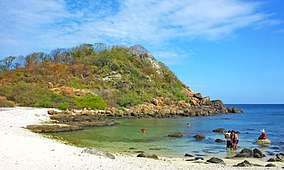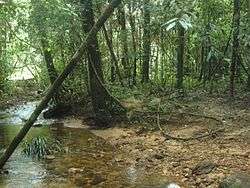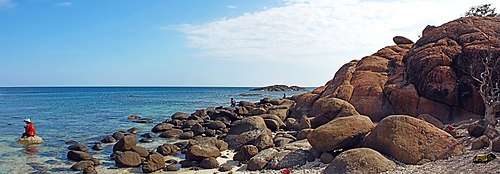Protected areas of Sri Lanka
Protected areas of Sri Lanka are administrated by Department of Forest Conservation and Department of Wildlife Conservation of Sri Lanka.There are 501 protected areas in Sri Lanka.[1] The protected areas falls under supervision Department of Forest Conservation include forests defined in National Heritage Wilderness Area Act in 1988, forest reservations and forests manage for sustainability.[2] World heritage site, Sinharaja Forest Reserve is an example for a National Heritage forest. There are 32 forests categorized as conservation forests including Knuckles Mountain Range. Strict nature reserves, national parks, nature reserves, forest corridors and sanctuaries recognized under the Flora and Fauna Protection Ordinance are managed by Department of Wildlife Conservation. Total of all categories of areas protected is 1,767,000 ha. Protected areas in Sri Lanka accounts for 26.5 percent of total area.[1] This is a higher percentage of protected areas than in all of Asia and much of the World.
| Part of a series on |
| Wildlife of Sri Lanka |
|---|
 |
|
Flora and fauna Birds (Endemics) Mammals (Endemics) |
|
Gardens Zoological gardens Pinnawela Elephant Orphanage Dehiwala Zoo Pinnawala Open Zoo Ridiyagama Safari Park Botanical gardens Hakgala Botanical Garden Henarathgoda Botanical Garden Mirijjawila Botanical Garden Peradeniya Botanic Gardens Seetawaka Botanical Garden |
|
Organizations Authorities Department of Forest Conservation Department of Wildlife Conservation Civil societies Field Ornithology Group |
|
Related topics |
Biodiversity
Plant diversity and endemism in Sri Lanka are quite high. Of 3,210 flowering plants belonging to 1,052 genera, 916 species and 18 genera are endemic.[3] All but one of Sri Lanka's more than 55 dipterocarp (Sinhalese "Hora") are found nowhere else in the world. Sri Lanka's amphibian diversity is only becoming known now. Sri Lanka may be home to as many as 140 species of amphibians. More than 50 known freshwater crabs are confined to Sri Lanka.
Deforestation
Between 1990 and 2000, Sri Lanka lost an average of 26,800 ha of forests per year.[4] This amounted to an average annual deforestation rate of 1.14 percent . Between 2000 and 2005 this accelerated to 1.43% per annum.
Conservation efforts
92 Key Biodiversity Areas (KBAs) have been identified through a process coordinated by the Wildlife Heritage Trust and University of Peradeniya.[5] Many other data and published literature were also incorporated into the analysis, notably data on Important Bird Areas collected by the Field Ornithology Group of Sri Lanka. Nearly all of these KBAs lie in the wet zone in south western part of the country. These areas considered irreplaceable because all sites contain endemic species that found nowhere else, with some of them harboring more than 100 globally threatened species.
The flora and fauna of Sri Lanka are heavily understudied. For instance the Serendib scops owl was described and nine other bird species added to the list of endemics only in 2004.[5] Thus the number of endemic species is likely to be a gross underestimate.
Forest reserves and proposed reserves
A number of forest reserves and proposed reserves are managed by Department of Forest Conservation. These areas are ecosystems with rich biodiversity.[6] Some of the forest reserves and proposed reserves include[2]
|
|
|
Biosphere reserves

There are four biosphere reserves declared under UNESCO's Man and Biosphere Reserve Programme. Those are Bundala, Hurulu, Kanneliya-Dediyagala-Nakiyadeniya (KDN) and Sinharaja.[7] Apart from these international biosphere reserves there are national biosphere reserves being designated. Thirty-three are administrated by Department of Forest conservation and another four by Department of Wildlife Conservation.[8]
National protected areas
National protected areas are mainly classified into six types.[9] The first four categories of protected areas cover all the ecological and regions of Sri Lanka. The 5th, 6th and 7th categories were introduced in 1993 by amending the Flora and Fauna Protection Ordinance. However, no regions have been declared under these categories so far.
- Strict nature reserves
- National parks
- Nature reserves
- Jungle corridors
- Refuge
- Marine reserves
- Buffer zones
- Sanctuaries
Strict nature reserves
.jpg)
Human activities are restricted in SNRs and they are protected as a pure natural system. Researchers are allowed under the supervision of the Department of Wildlife Conservation staff and with the prior approval of the director.[6]
| Protected area | Area | Date of declaration |
|---|---|---|
| Hakgala | 1,141.6 | |
| Yala | 28,904.7 | |
| Ritigala | 1,528.1 | |
Source:[6]
National parks

National parks are areas allowed for the public to see and study wildlife. However necessary rules and regulations are introduced to protect wildlife and their habitats.
Nature reserves
.jpg)
Wildlife viewing and studying is restricted in these areas. Similar to Strict nature reserves scientific researches are encouraged under the supervision of Department of Wildlife Conservation staff. These areas differ from strict nature reserves by allowing traditional human activities to continue.
| Protected area | Area | Date of declaration |
|---|---|---|
| Triconamadu | 25,019.3 | |
| Riverine | 824.1 | |
| Minneriya-Girithale | ||
| Block I | 7,529.1 | |
| Block II | 1,923.6 | |
| Block III | 4,745.3 | |
| Block IV | 8,335.5 | |
| Wetahirakanda | 3,229 | |
| Peak Wilderness | 12,979 | |
| Nagar kovil | 7,882 | |
| Vidataltivu | 29,180 |
Source:[6]
Jungle corridors
The only jungle corridor declared under the accelerated Mahaweli Oleend Programme.
Sanctuaries
Sanctuaries ensure the protection of wildlife of private lands which outside the state claim. In the sanctuaries protection of habitat and allowing of human activities occur simultaneously. Permission is not required for entry to these lands.
References
- "Biodiversity and Protected Areas – Sri Lanka". biodiversityhotspots.org. EarthTrends. Archived from the original on 2008-12-02. Retrieved 2009-04-21.
- Senarathna, P. M. (2005). Sri Lankawe Wananthara (in Sinhala) (1st ed.). Sarasavi Publishers. pp. 13–17. ISBN 955-573-401-1.
- "Western Ghats and Sri Lanka". biodiversityhotspots.org. Conservation International. Archived from the original on 2009-05-04. Retrieved 2009-04-21.
- "Sri Lanka". mongabay.com. Mongabay. Retrieved 2009-04-21.
- "Conservation action and protected areas". biodiversityhotspots.org. Conservation International. Archived from the original on 2007-07-14. Retrieved 2009-04-21.
- The National Atlas of Sri Lanka (2nd ed.). Department of Survey. 2007. ISBN 955-9059-04-1.
- "Sri Lanka". unesco.org. UNESCO. Retrieved 2009-10-06.
- "Forest management in Sri Lanka". mablanka.lk. Sri Lanka MAB programme. 2005. Archived from the original on February 10, 2006. Retrieved 2009-10-06.CS1 maint: unfit url (link)
- "Protected Areas". dwlc.lk. Department of Wildlife Conservation. Archived from the original on 2005-08-29. Retrieved 2009-04-21.
External links
| Wikimedia Commons has media related to Protected areas of Sri Lanka. |